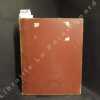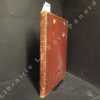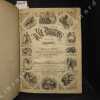-
Type
Autograph (3)
Book (25595)
Drawings (9)
Engraving (16)
Magazine (105)
Manuscript (5)
Maps (20)
Music sheets (41)
Old papers (3)
Photographs (9)
Postcards (2)
Posters (1)
Public sale (1)
-
Latest
Last 24h (36)
Last 3 days (12)
Last month (142)
Last week (15)
-
Language
Czech (2)
Dutch (1)
English (24)
French (25773)
German (4)
Italian (2)
Latin (1)
Spanish (3)
-
Century
16th (9)
17th (88)
18th (582)
19th (4539)
20th (10350)
21st (1245)
-
Countries
Belgium (398)
Canada (44)
Côte d'Ivoire (42)
Denmark (763)
France (22344)
Germany (208)
Greece (4)
Italy (1)
Netherlands (4)
Switzerland (2002)
-
Syndicate
ALAC (44)
CLAM (6)
CLAQ (39)
CNE (13)
ILAB (14546)
NVVA (316)
SLACES (312)
SLAM (13292)
SNCAO (9)
Géographie physique, historique et militaire.
G. Charpentier. 1880. In-8. Relié. Etat d'usage, Coins frottés, Dos abîmé, Quelques rousseurs. 702 pages, plats jaspés - papier jauni, dos manquant, tranches et plats frottés, plats partiellement désolidarisés du corps de l'ouvrage, annotations à l'encre sur le 1er contreplat, pages de garde et de faux-titre.. . . . Classification Dewey : 910-Géographie générale. Voyages
Nouvelle édition refondue, corrigée et augmentée par M.P. Martine. Classification Dewey : 910-Géographie générale. Voyages
L’Abbaye du Bec-Hellouin. Photographies de Jacques Verroust.
Paris, Editions Sun 1966, 215x195mm, 95pages, broché. Sous jaquette. Bel exemplaire.
photos en héliogravure, Pour un paiement via PayPal, veuillez nous en faire la demande et nous vous enverrons une facture PayPal
L’Abbaye du Bec-Hellouin. Photographies de Michel Brieux.
Sans lieu, Editions des Ateliers de Bec 1982, 215x195mm, 106pages, broché. Sous jaquette. Bel exemplaire.
photos n/b, Pour un paiement via PayPal, veuillez nous en faire la demande et nous vous enverrons une facture PayPal
Le Triomphe de la navigation aérienne. Aéroplanes - Dirigeables - Sphériques.
Paris, Tallandier, Paris, Tallandier(1911) ; grand in-4, cartonnage percaline rouge, décor doré sur le plat et le dos. (Reliure de l’éditeur) 2 ff., 293 pp., 1 f. de table.ÉDITION ORIGINALE. Ouvrage remarquable, avec de très nombreuses illustrations photographiques. Le comte Henry de La Vaulx (Bierville 1870 - Jersey City USA 1930) était un aventurier sportif. En 1896 il effectua pendant un an un voyage équestre en Patagonie. Mais sa grande passion était la course en ballon. Disciple de Jules Verne, compagnon de Mermoz, il fut l’un des fondateurs de l’Aéro-club de France. En 1905 il devint le président de la Fédération aéronautique internationale. Avec Maurice Mallet, il fonda la société Zodiac pour construire des dirigeables et plus tard des bateaux gonflables. Henry de La Vaulx est mort en avril 1930 dans le New Jersey dans un accident d’avion. On lui doit, une dizaine d’ouvrages sur l’aéronautique, mais également des romans d’aventures, le récit de son voyage en Patagonie et deux autres ouvrages sur la Patagonie.
COLONISATION DE MADAGASCAR.
PARIS. AU SECRETARIAT DE LA SOCIETE MARITIME. CHEZ AMYOT, LIBRAIRE. 1844. IN-8 BROCHE (14 X 24,5 X 1,5 CENTIMETRES ENVIRON) DE (4) + VIII + 197 ET (1) PAGES, COUVERTURE FACTICE MUETTE PAPIER MARBRE, AVEC PETITE RESTAURATION. ILLUSTRE D’UNE CARTE EN COULEURS REPLIEE. ENVOI D’AUTEUR : « MONSIEUR LE REDACTEUR EN CHEF DE L’ESTAFETTE. HOMMAGE DE L’AUTEUR». EDITION ORIGINALE RARE (GRANDIDIER. 3046). BON EXEMPLAIRE.
Les voyageurs chimeriques.
Lyon, Lardanchet, 1941 (1944), in 12 broché, 317 pages ; non coupé ; couverture légèrement fanée.
PHOTOS sur DEMANDE. ...................... Photos sur demande ..........................


Phone number : 04 77 32 63 69
Les voyageurs chimériques
Lardanchet 1941 13x19. 1941. Broché. 316 pages. Bon état (BE) interieur propre et sans rousseurs légères taches sur le plat de couverture
REVUE DES MUSEES D'ITALIE - catalogue raisonné des peintures et sculptures exposées dans les galeries publiques et particuliéres et dans les église
TARDIEU 1862 ,br.;490p . dos cassé
Remise de 20% pour toutes commandes égales ou supérieures à 200 €
La Vie Parisienne. Dirigée par MARCELIN [puis BAUDOUIN] Moeurs élégantes. Choses du jour - Fantaisies - Voyages. Théâtre - Musique. -
Paris, du 17/11/1877-1878 (année complete),105+ 780p., fort volume in-4 demi-chagrin rouge, dos à cinq faux-nerfs, nombreuses illustrations dans le texte par CRAFTY, GILLOT, YVES & Barrets, SAHIB, etc. Index. publicités,;plats défraîchis ; certains bords dentelés.
Remise de 20% pour toutes commandes égales ou supérieures à 200 €
La vie parisienne - Moeurs élégantes, choses du jour, fantaisies, voyages, théâtre, musique, modes - MARCELIN (Directeur)
Reference : 115077
(1874)
La vie parisienne. Année 1874 : Du numéro 1 (Du samedi 3 janvier 1874) au 19 décembre 1874 puis quelques pages du 16 janvier 1875
1874 Année 1874 incomplète - 12e année - Revue hebdomadaire illustrée, un numéro tous les samedis - In-folio, demi basane rouge avec titre, filets et fleurons dorés au dos - Pagination non continue : p. 1 à 200 (4 avril 1874) puis p. 229 (25 avril 1874) à 242, puis p. 313 (6 juin 1874) à 368, puis p. 482 à 494 (29 août 1874), puis p. 649 (21 novembre 1874) à 662, puis p. 705 (19 décembre 1874) à 717, enfin quelques pages du 16 janvier 1875 (p. 29 à 42)
Assez bon état - Année incomplète - Plats et dos frottés - Petits accrocs au niveaux des mors - Coins, bords et coiffes frottés - Pagination non continue (manque quelques numéros)
Destinations de rêve les plus beaux voyages du monde
France loisirs 1996 224 pages in4. 1996. Relié jaquette. 224 pages.
Très Bon Etat intérieur très frais
Etudes sur l’histoire de Prusse
Paris, Librairie Hachette 1879. Grand In/8 reliure demi-chagrin rouge, caissons et titres dorés, 324 p.
Ernest Lavisse, 1842 / 1922, historien français. Lavisse, boursier, intègre l’École normale supérieure en 1862. Il devient très rapidement précepteur du prince impérial sur recommandation de Duruy puis membre de son cabinet. La défaite de 1870 touche au plus profond de lui-même ce protégé du régime. Décidé à œuvrer pour sa patrie vaincue, muni d’un modeste viatique, il part étudier le fonctionnement du système universitaire de l’Allemagne victorieuse. Durant trois années, il étudie sur place l’histoire et les origines de la Prusse, thème qui restera sa spécialité. Personnage phare de la IIIe République, membre de l’Académie française en 1892, directeur de la Revue de Paris en 1894, instituteur national, surtout lorsqu’il devient, en 1904, directeur de l’École normale supérieure, Lavisse mène durant toute sa carrière la régénération du système universitaire et scolaire du régime.
TOME I - PREMIERE PARTIE / HISTOIRE DE FRANCE ILLUSTREE DEPUIS LES ORIGINES JUSQU'A LA REVOLUTION : Tableau de la géographie de la France par P. Vidal de la Blache
HACHETTE. NON DATE. In-8. Broché. Bon état, Couv. défraîchie, Dos satisfaisant, Intérieur frais. 396 pages. Nombreuses photos et cartes en noir et blanc, dans et hors texte + 1 carte dépliante en couleurs, d'environ 50*35cm.. . . . Classification Dewey : 910-Géographie générale. Voyages
Classification Dewey : 910-Géographie générale. Voyages
DEPECHES SECRETES D'ARABIE
2 VOLUMES EN 1 In 8° (220 x 120 mm) Relié plein maroquin rouge, dos à 5 nerfs XXIX -1001 pp, couverture conservée, illustré de photos Très bel exemplaire P2-1D
Seven Pillars of Wisdom a triumph.
London, Jonathan Cape, (1935). 4to. Uncut in orig. full cloth. Gilt lettering on back and gilt crossed swords on frontcover. A small library number on back. Binding slightly rubbed. 672 pp., 4 folded maps and many plates in photogravure. One map with a tear, no loss, the tear taped on verso.
First published for General circulation 1935. First issue (illustrations on pp.304-5).
Seven Pillars of Wisdom a triumph.
London, Jonathan Cape, (1935). 4to. Uncut in orig. full cloth. Gilt lettering on back and gilt crossed swords on frontcover. Binding slightly rubbed. 672 pp., 4 folded maps and many plates in photogravure.
Seven Pillars of Wisdom a triumph.
London, Jonathan Cape, (1935). 4to. Uncut in orig. full cloth. Gilt lettering on back and gilt crossed swords on frontcover. Spine faded. 672 pp., 4 folded maps and many plates in photogravure.
First trade edition.
This is new brunswick
The ryerson press 202 pages in8. Sans date. Relié jaquette. 202 pages.
Etat Correct jaquette défraichie tranche salie
Allerneuste Beschreibung der Provintz Carolina In West-Indien. Samt einem Reise-Journal von mehr als Tausend Meilen unter allerhand Indianischen Nationen. Auch einer Accuraten Land-Carte und andern Kupfer-Stichen. Aus dem Englischen ubersetzet... - [FIRST TRANSLATION OF ""THE FIRST HISTORY OF CAROLINA""]
Hamburg,von Wiering, 1712. 8vo. In contemporary full calf with four raised bands. Embossed ornamentation to spine. Lower part of back hindge and back board with worm hole. Last three works with small wormtract to lower part of leaves (not affecting Lawson's work, other wise a good copy. [Lawson:] (14), 365, (3) pp. + frontispiece and 1 folded map" (4), 239, (5) (2), 94" (2), 134 pp.
The exceedingly rare first German translation of ""the first history of Carolina, with a very observant report of the life, customs, and natural history of the colony"" (Streeter). John Lawson’s work offers a largescale portrayal of the customs and traditions of the Native American tribes during that era, while also serving as a meticulous record of the Carolinas' geography, climate, flora, fauna, and aquatic life, it constitute one of the most valuable contributions to the early history of Carolina and is considered to be one of the first travel account of the early 18th-century colonies. Lawson’s book provided a meticulous account of his 550-mile, 57-day journey through the backcountry of what would eventually become the states of both South Carolina and North Carolina. Beginning in the port city of Charles Town in December 1700, Lawson and nine other adventurers traveled northwestward toward present-day Charlotte, North Carolina. From there he explored the Piedmont basins of the Catawba and Yadkin Rivers before turning eastward toward present-day Bath, arriving there late in February 1701. John Lawson (1674 - 1711) was an English explorer, adventurer and writer. From 1700 onwards, Lawson was instrumental in the exploration and development of the northern part of what was then the British colony of Carolina, today's US state of North Carolina. Little is known about Lawson's life before his arrival in Carolina. In 1700 he traveled to America and arrived in Charleston where Lawson began a two-month expedition by canoe up the Santee River with five other British and various Indian guides to explore the then unknown land north of Charleston. The expedition ended about 1,000 kilometers further north at the mouth of the Pamlico River (now in Beaufort County). During the expedition, Lawson took extensive notes, which eventually was published in the present work. After the expedition ended, Lawson acquired land in the area where the expedition had ended and worked there, first privately and then on behalf of the colonial administration as a surveyor. At this point, a few scattered Europeans had already settled in the area. Lawson's holdings grew into North Carolina's first permanent settlement, Bath, which soon prospered and became North Carolina's most important port of entry. Lawson was involved with the Swiss Christoph von Graffenried and Franz Ludwig Michel in the founding of North Carolina's second oldest city, New Bern, by Swiss and German immigrants in 1710. Lawson was kidnapped and subsequently killed by the Tuscarora in 1711 after they noticed that Lawson had tried to take advantage of them in a trade. This event led to a deterioration in the climate between the Europeans and the Tuscarora and thus contributed to the outbreak of the Tuscarora War, which, after the initial successes of the Tuscarora, ended with their expulsion. Sabin 39453
Au long cours en 2 CV.
P., Presses de la Cité, 1968 ; in-8. 321pp. - 8ff. hors-texte d'illustrations en noir. Cartonnage d'éditeur. Jaquette couleur. Bon état.
Récit agrémenté de photographies, d'un tour du monde en 2 CV : depuis Paris, à travers les Balkans, le Moyen Orient, l'Inde, la péninsule indochinoise, le Japon, traversée du Pacifique puis de l'Amérique du Nord avant de rembarquer pour la France.
 Write to the booksellers
Write to the booksellers













